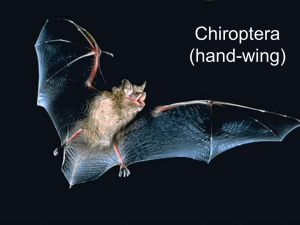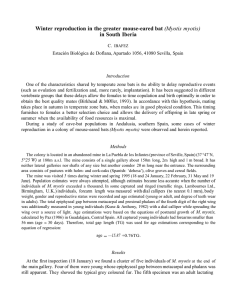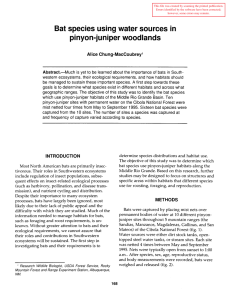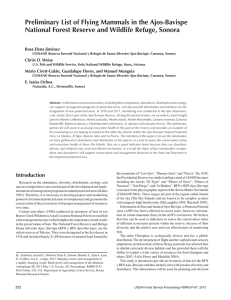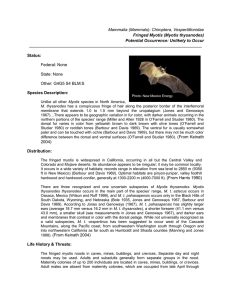1997 zoogeography m myotis_blythii j zool.doc
advertisement
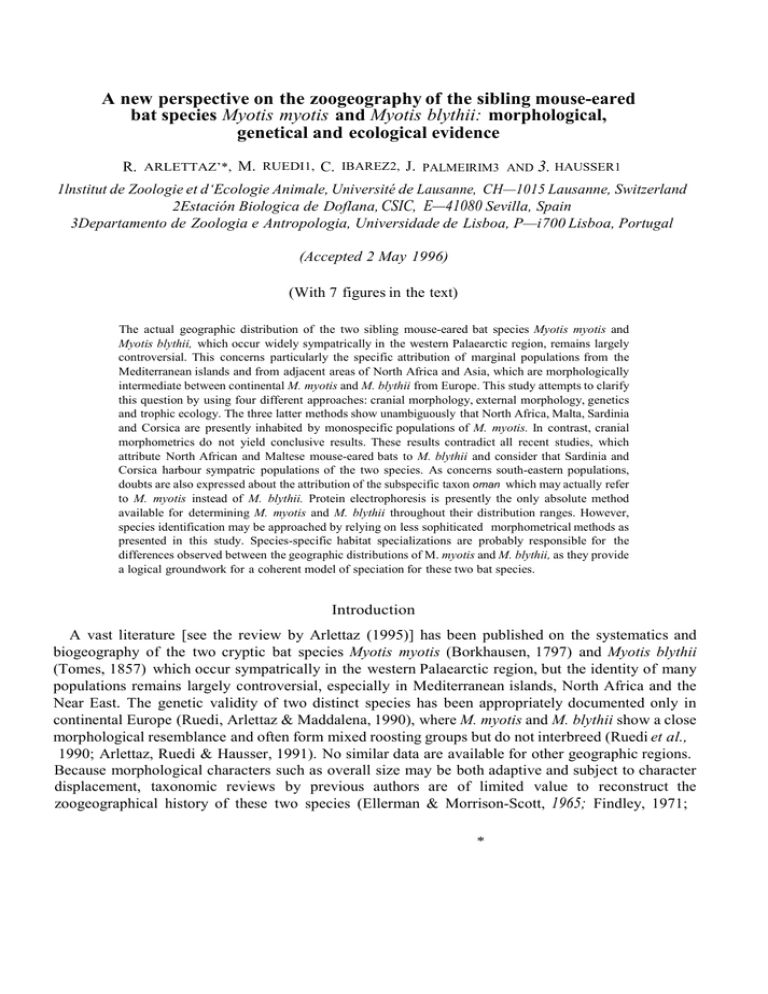
A new perspective on the zoogeography of the sibling mouse-eared bat species Myotis myotis and Myotis blythii: morphological, genetical and ecological evidence R. ARLETTAZ’*, M. RUEDI1, C. IBAREZ2, J. PALMEIRIM3 AND 3. HAUSSER1 1lnstitut de Zoologie et d‘Ecologie Animale, Université de Lausanne, CH—1015 Lausanne, Switzerland 2Estación Biologica de Doflana, CSIC, E—41080 Sevilla, Spain 3Departamento de Zoologia e Antropologia, Universidade de Lisboa, P—i700 Lisboa, Portugal (Accepted 2 May 1996) (With 7 figures in the text) The actual geographic distribution of the two sibling mouse-eared bat species Myotis myotis and Myotis blythii, which occur widely sympatrically in the western Palaearctic region, remains largely controversial. This concerns particularly the specific attribution of marginal populations from the Mediterranean islands and from adjacent areas of North Africa and Asia, which are morphologically intermediate between continental M. myotis and M. blythii from Europe. This study attempts to clarify this question by using four different approaches: cranial morphology, external morphology, genetics and trophic ecology. The three latter methods show unambiguously that North Africa, Malta, Sardinia and Corsica are presently inhabited by monospecific populations of M. myotis. In contrast, cranial morphometrics do not yield conclusive results. These results contradict all recent studies, which attribute North African and Maltese mouse-eared bats to M. blythii and consider that Sardinia and Corsica harbour sympatric populations of the two species. As concerns south-eastern populations, doubts are also expressed about the attribution of the subspecific taxon oman which may actually refer to M. myotis instead of M. blythii. Protein electrophoresis is presently the only absolute method available for determining M. myotis and M. blythii throughout their distribution ranges. However, species identification may be approached by relying on less sophiticated morphometrical methods as presented in this study. Species-specific habitat specializations are probably responsible for the differences observed between the geographic distributions of M. myotis and M. blythii, as they provide a logical groundwork for a coherent model of speciation for these two bat species. Introduction A vast literature [see the review by Arlettaz (1995)] has been published on the systematics and biogeography of the two cryptic bat species Myotis myotis (Borkhausen, 1797) and Myotis blythii (Tomes, 1857) which occur sympatrically in the western Palaearctic region, but the identity of many populations remains largely controversial, especially in Mediterranean islands, North Africa and the Near East. The genetic validity of two distinct species has been appropriately documented only in continental Europe (Ruedi, Arlettaz & Maddalena, 1990), where M. myotis and M. blythii show a close morphological resemblance and often form mixed roosting groups but do not interbreed (Ruedi et al., 1990; Arlettaz, Ruedi & Hausser, 1991). No similar data are available for other geographic regions. Because morphological characters such as overall size may be both adaptive and subject to character displacement, taxonomic reviews by previous authors are of limited value to reconstruct the zoogeographical history of these two species (Ellerman & Morrison-Scott, 1965; Findley, 1971; * , Strelkov, 1972; Felten, Spitzenberger & Storch, 1977; Bogan et al., 1978; Corbet, 1978; Koopman, 1993). Thus, a basic knowledge of the distributions of both mouse-eared bat species remains unclear. The present study attempts to clarify the zoogeography of M. myotis and M. blythii in the western part of their range by considering cranial morphology,: eçternal morphology, genetics and ecology. Material and methods Morphometrics Cranial morphology Seven different skull measurements were taken on 56 specimens (31 M. myotis and 25 M. blythii) collected from 12 regions in Morocco, Spain, Sardinia, Corsica, Switzerland, Turkey and Kirghizstan (Table I). These variables are greatest skull length (GL, measured from the second incisive), interorbital constriction (IC), braincase width (BC), zygomatic breadth (ZB), inter-canines width (CC), inter-molars width (MM) and maxillary tooth row (canines to molars, CM3). These measurements are illustrated in Arlettaz (1995). To minimize the impact on natural populations, only 2—7 individuals were collected from each region. Because skull size is correlated with body size, the smallest and the largest individuals were selected among the bats captured in each region. Skull size was not representative of a population as a whole, but was most likely to include individuals of the 2 species in sympatric populations. Further material previously collected was also measured (Morocco and Spain, Estación Biológica Ponana, Sevilla, Collection C. Ibafiez, ii = 20; Institute of Zoology and Animal Ecology, Lausanne, Collection M. Ruedi, n = 3). For all specimens tissues were also available for genetic analyses. External morphology Forearm length and ear length were measured on all living individuals (n = 503 M. myotis and 426 M. blythii) captured in 11 populations; discriminant scores were computed according to the method outlined in Arlettaz, Ruedi & Hausser (1991). In central Europe, this technique allowed a good separation of the 2 species, with a probability of correct classification of over 99%. The presence of a white spot of hair on the head, typical of M. blythii, was also checked (Arlettaz et a!., 1991). Genetics All individuals collected were identified by an allozyme analysis of tissue samples according to the methods outlined in Ruedi et a!. (1990). Two loci discriminant among M. myotis and M, blythii in western and central Europe were used to identify each individual: GOT-i (Enzyme Commission number 2.6.1.1) and MPI (EC 5.3.1.8). We assessed genetic variability between various samples with 7 additional loci. These are ADA (EC 3.5A.4) G-6-PD (EC 1.1.1.49), GOT-2 (EC 2.6.1.1), ME-i and ME-2 (EC 1.1.1.40), 6-PGD (EC 1.1.1.44) and GPI (EC 5.3.1.9). Buffer solutions and electrophoretic conditions are described in Ruedi eta!. (1990), except for ADA which was run on a Phosphate buffer (pH 6.7) for 15 hours at 45 V/cm and stained according to Harris & Hopkinson (1976). Allele frequencies for each population were computed and transformed into unbiased genetic distances (Nei, 1978). The genetic relationships between the populations were represented on a UPGMA phenogram (Sneath & Sokal, 1973). Precise location and access number to reference samples are available upon request to the senior author. , Ecology The diet of both species was studied by faecal analysis (Kunz & Whitaker, 1983; Dickmann & Huang, 1988) using individual faecal samples collected from live-trapped individuals in 9 populations: North and South TABLE I Origin of the material investigated for skull moiphology and genetics, external morphology, and faecal analysis Locality Number of collection sites Individuals collected for skulls and tissues Approximate coordinates M. myotis M. blythii Collection’ Individuals measured for external morphology M. myotis M. blythii Faecal samples M. myotis M. blythii C Switzerland Valais (Fully, Raron, Naters) Switzerland 2 Portugal (Lousal, Querença) Spain Andalusia (Jerez, Cadiz, Tarifa, Malaga) Rioja Catalufia (Barcelona) Levante (Valencia) Morocco Nil (Tanger, Tetouan) Middle Atlas (Berkane, Taza Merbraoua, El Hajeb) Rabat Sahara (Tazouguerte) Malta Sardinia (Mt Maiore, Borutta, Pozzomaggiore, Ulàssai) Corsica (Oletta, Castifao) Turkey (Dongel Magarasi) Kirghizstan SW (Os, Kyzyl-Kija) Total 4 10 2 46°15’N, 07°30’E 47°20’N, 09°00’E 37°40’N, 08°40’W 5 4 1 1 1 36°30’N, 06°30’W 42°30’N, 02°30’W 41°30’N, 02°00’E 39°30’N, 00°30’W 8 2 2 2 35°50’N, 05°30’W 6 EBD, IZEA 10 4 34°10’N, 03°00’W 33°50’N, 04°00’W 34°00’N, 07°00’W 3roo’N, 03°20’W 35°50’N, 14°30’E 4 IZEA 69 40°30’N, 09°00’E 42°30’N, 09°15’E 38°00’N, 36°30’E 40°20’N, 72°30’E 3 2 2 1 1 1 4 2 1 7 46 105 67 36 5 5 1 3 146 28 18 169 0 0 0 LI 13 20 1 z 2 35 IZEA IZEA 7 21 0 15 22 EBD, IZEA EBD EA EBD 100 71 IZEA 503 8 13 212 426 ‘IZEA = Institute of Zoology and Animal Ecology, University of Lausanne, Switzerland; EBD = Estación Biológica Donana, Sevilla, Spain more details about the location of these 10 localities, see Arlettaz et al. (1994) 2 152 19 13 58 230 242 Morocco, Portugal, Malta, Sardinia, Corsica, NE and SW Switzerland, and Kirghizstan (for sample sizes, see Table I). The percentage volume of ground-dwelling and grass-dwelling prey categories, typical of M. myotis and M. blythii, respectively, was assessed [see Arlettaz & Perrin (1995) for more details]. In the Swiss sympatric populations, these 2 main prey categories are, species-specifically, the dominant prey groups throughout the season (Arlettaz, 1995). Statistics Principal component (PCA) and discriminant analyses were performed on morphological variables and all analyses were computed using the Systat package for the Macintosh (Wilkinson, Hill & yang, 1992). Results Morphometrics Cranial morphology A principal component analysis (PCA) performed on the covariance matrix showed that the first factor (PC1) accounted for 89% of the overall variance, whereas the second factor (PC2) accounted for only 4% (Fig. 1). PC1 was highly correlated with variables expressing skull length, tooth row length and skull width (GL, r = 0.989; CM3, r = 0.965; ZB, r = 0.937). PC2 was most correlated with maxillary width (CC, r = 0.415; MM, r = 0.351) (Table II). A plot showing the relationship between these first two components (Fig. 1) clustered the populations of mainland Europe in two distinct groups, comprising, respectively, the smaller and the larger individuals. Individuals from Mediterranean islands and North Africa (Morocco) grouped together in an intermediate cluster, whereas the two Turkish specimens chosen for their extreme phenotypes fell in the middle and right clusters. Kirghiz mouse-eared bats were clearly the smallest individuals. A second PCA performed on the same variables adjusted for size (i.e. divided by GL and log-normalized) did not yield a clearer grouping. External morphology The frequency distribution of the discriminant scores obtained for the various populations showed a clear bimodality for Switzerland and Spain, but not for the Portuguese samples which clustered near zero. The distribution of scores for Morocco, Sardima and Corsica was unimodal and coincided more closely with the Swiss M. myotis, whereas the distribution of Kirghiz individuals was unimodal and coincided with the Swiss M. blythii (Fig. 2). Only some of the individuals from Switzerland, Spain and Portugal had a spot of white hairs on the head, a feature characteristic of M. blythii (Arlettaz et al., 1991). By contrast, nearly all (i.e. > 95%) individuals from Kirghizstan exhibited this character, whereas no individual from Morocco, Sardinia and Corsica did so. Thus, both the frequency distribution of discriminant scores and the presence/absence of the white spot suggest: 1) the occurrence of sympatric populations of the two species in the three countries of continental Europe; 2) the existence of monospecific populations of M. blythii in Kirghizstan; and 3) the occurrence of monospecific populations of M. myotis in Morocco, Sardinia and Corsica. Genetics Among the nine studied loci, four were monomorphic across all individuals (GOT-2, ME-i and 2, G-6-PD). Of the polymorphic ones, MPI could not be reliably scored in all populations and was ZOOGEOGRAPHY oP MYOTIS MYOTIS AND M. BLYTHII 49 1.2 0.8— - C, — - C - 0.6— • > 0 - 0.40.2- 0 cI 0.0= —0.4 — - —0.6 -3 —2 1 0 Factor 1 (PCi = 2 3 89% of variance) Fia. 1. Relationships between Factor 1 and Factor 2 (Principal component analysis, PCA) for 56 mouse-eared bat skulls from various origins. Individuals from continental Europe (shown by symbols 1, 2, 4) clustered in two distinct groups [smaller individuals (on the left) and larger ones (on the right)], whereas mouse-eared bat populations from the Mediterranean islands and Morocco appeared intermediate (middle cluster). Note that the two Turldsh specimens (8) were split between the middle and right clusters, and that Kirghiz individuals (9) were the smallest specimens. 1 = Switzerland; 2 = Catalufla; 4 = Spain (except Catalufia); 5 = Morocco; 6 = Sardinia; 7 = Corsica; 8 = Turkey; 9 = Kirghizstan. TABLE II Correlation matrix showing the relationships between cranial variables and factors I and 2 (PCI and PC2) obtained from principal component analysis. For variables and PCI, all correlation coefficients were highly significant (P < 0.007). For variable abbreviations, see Material and methods Variable ZB BC IC CC MM CM3 PCi GL ZB BC IC CC 0.900 0.681 0.385 0.751 0.823 0.960 0.989 0.742 0.427 0.790 0.811 0.852 0.937 0.566 0.611 0.615 0.592 0,713 0.439 0.364 0.356 0.418 0.842 0.752 0.813 —0.137 0.162 0.261 0.265 0.415 0.848 0.881 0.351 0.965 —0.111 50 R. ARLETTAZ ET AL. Discriminant scores FIG. 2. Frequency distribution of the scores obtained from a discriminant function including two external characters (forearm and ear length) and applied to different mouse-eared bat populations. This equation allowed a correct classification of more than 99% Swiss individuals whose identity was biochemically assessed (Arlettaz et al., 1991). Distributions are bimodal for Switzerland and Spain, but unimodal for Morocco, Sardinia, Corsica and Kirghizstan; distribution also appears unimodal for Portugal but specimens were grouped together near zero (for more details about localities, see Table I). ZOOGEOGRAPHY OF MYOTIS MYOTIS AND M. BLYTHII Switzerland M. myotis Spain M. myotis 51 Morocco Sardinia Corsica Turkey Switzerland M. blythil Spain M blythii Kirghlzstan Fin. 3. UPGMA phenogram showing the genetic relationships between the different mouse-eared bat populations investigated by protein electrophoresis (see Table IV), Populations from Mediterranean islands, North Africa and Turkey clustered with continental M. myotis, whereas Kirghiz individuals were gmuped within the M. blythii’s cluster. therefore excluded from subsequent analyses. Allele frequencies of the four variable loci are presented in Table [i GOT-i and ADA proved to be fixed for distinct alleles in the parental species in Switzerland, Spain and Kirghizstan. They were thus used to diagnose other populations of uncertain status. Under this criteria, samples from Morocco, Sardinia, Corsica and Turkey all represented M. myotis. Although not fully discriminant, 6-PGD also supports the same identification, as the most common allele (+100) found in continental M. myotis is also shared by these unidentified populations; M. blythii from Switzerland, Spain or Kirghizstan are all fixed for another allele (+115). Table IV presents the matrix of genetic distances (Nei, 1978) between all pairs of populations. Because of the small number of loci examined, genetic distances should be used for relative comparisons only. However, the UPGMA dendrogram based on Nei’s genetic distances showed a sharp dichotomy: the distance between the two main clusters is much greater than the second greatest distance, which separated the continental M. myotis from the Mediterranean ones (Fig. 3). Indeed, populations from Mediterranean islands, North Africa and Turkey clustered with the Swiss and Iberian M. myotis, whereas Kirghiz mouse-eared bats grouped together with Swiss and Iberian M. blythii. . Trophic ecology The proportions of ground- vs. grass-dwelling prey in the diets of mouse-eared bats from Morocco, Malta, Sardinia and Corsica were similar to the proportions found in Swiss and Portuguese M. myotis, whereas the food of Kirghiz mouse-eared bats most resembled the diet of M. blythii from continental Europe (Fig. 4). Discussion A critical zoogeographical review The study of external morphology, genetics and dietary ecology showed that monospecific populations of M. myotis inhabit Morocco, Sardinia and Corsica. By contrast, cranial morphometrics (1. TABLE III Allelic frequencies for the fourpolymorphic protein loci revealed from mouse-eared bats originating from various populations. Allele designations according to Ruedi etaL (1990) Switzerland Locus 6-PGD ADA GPI GOT-i Allele +115 +100 +100 +90 —60 -100 —15 —20 -100 Spain M. myotis 5 M. blyrhii 5 M. myotis M. blythii Morocco Sardinia Corsica Turkey Kirghisstan 12 9 11 3 2 2 7 0.25 0.75 1.00 1.00 0.10 0.90 1.00 1.00 0.05 0.95 1.00 1.00 1.00 — 0.47 0.53 — — 1.00 1.00 0.35 — 0.65 — — 1.00 1.00 — — — — 1.00 1.00 1.00 1.00 — — — — 0.95 1.00 1.00 1.00 0.05 — — 1.00 1.00 1.00 1.00 — — N 1.00 1.00 . — 1.00 1.00 — — 1.00 1.00 0.25 0.75 53 ZOOGEOGRAPHY OF MYOTIS MYOTIS AND M. BLYTHII TABLE IV Nei‘s genetic distance between the different populations of mouse-eared bats investigated by enzyme electrophoresis. Because only the four polymorphic loci were computed, genetic distances should be used for relative comparisons only Switzerland myotis Switzerland Spain Morocco Sardinia Corsica Turkey Kirghizstan myotis blythii myotis blythii Spain blythii myotis blythii Morocco Sardinia Corsica 0.000 0.000 1.386 0.000 1.386 Turkey — 1.582 0.000 2.093 1.582 0.065 0.000 1.361 2.093 0.098 1.361 0.084 0.084 0.098 1.582 1.386 1.386 1.320 0.000 0.116 0.116 0.129 2.093 1.386 1.386 1.320 0.000 — — — — 0.000 0.000 0.000 1.361 — — 1.320 Ground-dwelling prey in diet (%) FIn 4. Proportion of ground- and grass-dwelling prey in the diet of the different populations of mouse-eared bats. The diets of populations from North Africa and Mediteffanean islands were close to the ones of continental M. myotis from Europe, whereas the diet of Kirghiz mouse-eared bats clustered with the diets of Swiss and Portuguese M. blythii. 1 = SW Switzerland; 2 = NE Switzerland; 3 = Portugal; 5 = Morocco; 6 = Sardinia; 7 = Corsica; 9 = Kirghizstan. Malta is also indicated. 54 R. ARLETTAZ ETAL. did not yield conclusive results. The occurrence of only one mouse-eared bat species in North Africa (Morocco, Algeria, Tunisia and Libya) has been recognized by most authors (e.g. Ellerman & Morrison-Scott, 1965; Aellen & Strinati, 1970; Strelkov, 1972; Felten et a!., 1977; Bogan eta!., 1978; Hanak & Elgadi, 1984; Aulagnier & Thévenot, 1986; Horacek & Gaisler, 1986). However, most recent studies have attributed the North African mouse-eared bats toM. blythii (for an historical review about the specific attribution of North African mouse-eared bats, see Felten et a!., 1977: 38). Two investigators have expressed doubts about this specific identity. Strinati (1951) first referred all Moroccan specimens to M. myotis, but published a corrective note in 1953; Gaisler (1983) was surprised by the ear length of the specimens he collected in Algeria: “Remarquons que la longueur de l’oreille est nettement plus grande chez les exemplaires de notre collection par comparaison avec celle des exemplaires de M. b. oxygnathus en Europe”. Subspecifically, North African mouse-eared bats were referred to M. blythii oxygnathus by former authors, and to M. blythii oman by Strelkov (1972). Felten et al. (1977) even proposed a new subspecies for North Africa, M. blythii punicus. For Sardinia, Corsica and Malta, the taxonomy is also confused. Felten et a!. (1977) referred Corsican, Sardinian and Maltese mouse-eared bats to M. blythii punicus instead of M. b. oman. In Sardinia, Frick & Felten (1952) and Miller (1966) only reported the presence of M. myotis. Lanza [and not “Motta” as written by Strelkov (1972); M. Mucceda, pers. comm.] classified Sardinian mouseeared bats in the group intenmedia, whereas Strelkov (1972) attributed most Sardinian mouse-eared bats to M. blythii oman, although he did not deny the possible presence of M. myotis on that island. Kahmann & Goemer (1956) identified all mouse-eared bats found on Corsica as M. myotis and attributed smaller specimens found in owl pellets to immature M. myotis. Beaucournu1 (1965) reported the presence of a single M. blythii within a cluster of M. myotis, and Beaucournu, Launay & Noblet (1983) again referred to captures of the lesser species in Corsica. Menu & Popelard (1987) and Courtois, Faggio & Salotti (1992) suggested that specimens from Corsica may be morphologically closer to continental M. myotis than to mainland M. blythii. Specimens from Malta have been attributed toM. blythii oman (e.g. Strelkov, 1972) or toM. blythiipunicus (Borg et aL, 1990). Strelkov (1972) considered that there was no substantiated reason to believe that M. myotis also occurred on that island. However, there is now dietary evidence (this study) indicating that Maltese mouse-eared bats may actually belong to M. myotis. Because of their strong morphological similarity with Corsican, Sardinian and Maltese mouse-eared bats, specimens from Crete and Cyprus have been attributed to M. blythii oman (Strelkov, 1972; Spitzenberger, 1979; Iliopoulou-Georgudaki, 1979, 1984). Although we did not collect material from those islands, we would not be surprised that these two eastern Mediterranean islands also shelter populations of M. myotis and not of M. blythii. Incidentally, the distinction of the subspecies M. blythii lesviacus on Lesbos (Greece) seems hardly justifiable (Iliopoulou-Georgudaki & Giagia, 1984) until we know more about the specific identity of populations in that part of the Mediterranean. As concerns Asian populations, it is generally agreed that M. myotis and M. blythii occur sympatrically in the Near East and Asia Minor, and that regions to the east of Kurdistan are occupied by M. blythii only (Harrison & Lewis, 1961; Strelkov, 1972; Felten et aL, 1977; Deblase, 1980; Helversen, 1989; Albayrak, 1990; Harrison & Bates, 1991). The smaller mouse-eared bats occurring in Arabia (sensu lato) have been referred toM. blythii oman [or to its synonym M. b. nisonius, Harrison & Lewis (1961)] by most of these authors, although older reviews classified the eastern oman in ‘Note that in the same paper, Beaucournu (1965) attributed some specimens from north-eastern France (Anjou and Touraine) to M. blythii. However, a comparison of his measurements with our data from continental Europe suggests that these specimens belong to M. myotis ZOOGEOGRAPHY OF MYOTIS MYOTIS AND M. BLYTHI! 55 M. myotis (Thomas, 1905; Cheesman, 1921; Ellerman & Morrison-Scott, 1965). A comparison of the measurements of 36 skulls from Iran listed by Deblase (1980) with the measurements obtained in the present study suggests that pure populations of M. myotis may well occur in that region. Besides, Strelkov (1972) also noticed that “the size of Asian M. b. oman is very akin to M. myotis”. Our material from this geographic area consists of only two specimens, one phenotypically large and the other small. The skulls of these two individuals are situated at both extremes of the overall skull variation in M. myotis (Fig. 1), but are unambiguously identified as M. myotis by the genetic analysis (Table III and Fig. 3). The smaller individual appears in the intermediate group, along with western Mediterranean and North African mouse-eared bats (oman and punicus); the larger one is situated at the outermost edge of the cluster grouping larger individuals from continental Europe (myotis) and could be referred to the larger subspecies macrocephalicus described by Harrison & Lewis (1961) from Palestine. Obviously, in the absence of more details on size variation within Turkish populations, it is presently impossible to attribute these mouse-eared bats to any subspecific name within M. myotis. However, the presence of both small and large animals identified as M. myotis in Turkey raises doubts about the specific affiliation of the eastern populations referred to the taxon Oman (Transcaucasia, Near East, Arabia including Iran, and western Turkestan). In our opinion, it may represent M. myotis instead of M. blythii. Further genetic studies are needed in this area to solve this problem. Presently, it is impossible to draw a limit of M. myotis’ range in the Middle East, while it seems clear that M. blythii extends further east to India and Mongolia (Fig. 5). How to identify mouse-eared bats? Allelic mobility at two allozyme loci (GOT-i and ADA) provides the only absolute criteria which allow an unambiguous identification of single specimens (Table III). However, this diagnosis requires fresh material (either tissue or blood sample, see Ruedi et al., 1990) and an appropriate laboratory setting that is not accessible to most bat workers. Species identification may be possible using less sophisticated morphometric methods (Table V; Figs 6 & 7). In this case, relatively large samples are still needed in order to evaluate individual variation within populations (see Fig. 2), and to differentiate the two sibling species accurately. Discriminant functions may be used for the identification of both skulls and live individuals. Calculated on the whole skull sample (canonical correlation coefficient, r 0.834), a proposed discriminant function for species attribution is: Z = 4.231 x GL + 0.115 x ZB + 1.682 x CM3 110.987; if Z > 0, then M. myotis; if Z < 0, then M. blythii; this function has a probability of correct classification of 94%. As concerns external characters, Z = 0.433 x forearm length + 3.709 x ear length 114.887 (canonical corre’ation coefficient, r = 0.894); if Z > 0, then M. myotis, if Z <0, then M. blythii; probability of correct classification is 98%. Because M. myotis and M. blythii seem to have a fairly specialized trophic ecology (Fig. 4; Arlettaz, 1995; Arlettaz & Perrin, 1995), faecal analysis may also provide a useful guide for species identification, as long as individual faecal samples may be collected. — — Character displacement and niche shift The study of external morphology showed that the distributions of discriminant scores did not vary between sympatric and allopatric populations to the extent predicted by the model of character displacement (Grant, 1972). Similarly, there was no apparent difference in the dominant prey groups (ground- versus grass-dwelling arthropods) of either species under sympatric versus allopatric conditions. This suggests that M. myotis and M. blythii have probably evolved species-specific 56 R. ARLETTAZ ET AL. FIG. 5. (a) The prevailing view about the geographic distribution of M. myotis (black line) and M. blythii (grey line) in western Eurasia, with the currently accepted subspecific attribution of the different populations; according to Harrison & Lewis (1961), Strelkov (1972), Felten eta!. (1977) and Palmeirim (1979). (b) An updated geographical distribution of Myotis myotis and Myotis blythii (this study) in the western part of their distribution range. The broken line indicates the possible eastern extension of the taxon oman which is here hypothetically referred to M. myotis. ZOOGEOGRAPHY OF MYOTIS MYOTIS AND M. BLYTHII TABLE 57 V Skull measurements and results oft-tests on interspecific differences. For variable abbreviations, see text. Identification of each individual was assessed by protein analysis M. myotis (n Variable GL ZB BC IC CC MM CM3 23.26 14.69 9.92 5.30 6.04 9.57 9.57 M. blythii (n = 35) = 21) S.D. range mean S.D. range 0.64 0.41 0.23 0.19 0.29 0.44 0.36 21.80—24.10 13.70—15.56 9.48—10.34 4.95—5.77 5.50—6.58 8.69—10.33 8.60—10.17 21.42 13.75 9.63 5.19 5.67 8.87 8.67 0.53 20.34—22.37 13.08—14.38 9.10—10.18 5.03—5.51 5.28—6.01 8.35—9.35 8.02—9.01 0.39 0.28 0.13 0.22 0.28 0.24 P 11.65 8.46 3.99 2.54 5.33 7.23 11.21 <0.001 <0.001 <0.001 0.014 <0.001 <0.001 <0.001 morphological and ecological adaptations—which are nowadays fixed—and that they do not presently compete with each other. Ecology: towards a causal speciation model As understood in the light of present taxonomy, mouse-eared bats show the same species-specific dietary specializations throughout their western distributional range. This probably results from the exploitation of distinct species-specific foraging habitats (Arlettaz, Ruedi & Hausser, 1993). Myotis blythii has a larger distributional range than M. myotis, occurring from Portugal to Mongolia. As a predator of orthopterans, M. blythil appears primarily to be a grassland species (Arlettaz et al., 1993; Arlettaz, 1995). Thus, it is not surprising that its range largely coincides with the warm steppe belt. Moreover, like most elements of the steppe fauna, M. blythii has seemingly colonized some secondary grassland habitats (e.g. meadow- and pastureland), although it appears to avoid highly xeric environments and denuded areas. As far as we know, M. myotis is restricted to the western Palaearctic region. It shows a much greater latitudinal range than M. blythii, occurring from North Africa to the Baltic Sea. Most of its diet consists of ground-dwelling prey. Such prey can be captured in all habitats with open ground, i.e. either park-like mature forests (Rudolph, 1989; Audet, 1990; Arlettaz, 1995), overgrazed pastures or even desert-like habitats (Morocco). Palaeontological, morphological and genetic studies (Topal & Tusnadi, 1963; Strelkov, 1972; Topal, 1983; Fayard, 1984; Ruedi et al., 1990) suggest that the separation between M. blythii and M. myotis occurred during the Pleistocene. From the standpoint of cranial morphology, present-day M. blythii—the species which has also the widest distribution—seems closer to the ancestral form of mouse-eared bats. Indeed, in eastern Europe, M. blythii is already known from Middle Pliocene (Tertiary) deposits (Topal, 1983), whereas it appears only in the late Holocene within south-western European faunas (Sevilla, 1989). In contrast, the first fossil records of M. myotis in eastern Europe appear in the Late Pleistocene (Topal & Tusnadi, 1963), and in Spain in the Lower Pleistocene (Sevilla, 1989). In light of currently available data, the present study offers the first opportunity to propose a coherent—i.e. supported by sound ecological arguments—scenario of speciation forM. myotis and M. blythii. Sympatric speciation through disruptive selection via habitat specialization and assortative mating (Rice, 1987; Diehl & Bush, 1989) is hardly imaginable for mouse-eared bats owing to theft colonial habits; in Europe, under sympatric conditions, most maternity colonies are mixed, as are the 58 R. ARLETTAZ ET AL. Black symbols: M. myotis; grey symbols: M. blythii 4 84 4 E E ,;1442 6 5 52 15 C) 5 8 7 0 0 Cu 4$4 E 5 56 D 9 0 229® 992 0) C ci, -J 8 I 20 I I I I I I I I_I_L_l IIIIIIIIIIIIIIIIII 1111111 21 23 22 24 i2 E E 2 N 71 6 44 6i Cci ci, 6 4 C., 41 45 Cu E 0 2 0) 4/ 1 4 1 11 1 9 9 13 i 20 i i i i I 21 I I I I I I I 22 I I I I I I I I i I I I I 23 Greatest length of skull (GL, mm) I I I I 24 ZOOGEOGRAPHY OF MYOTIS MYOTIS AND M. BLYTHI! 59 El 29 M. myotis Q M. blythii Empty symbols: individuals misclassified by discriminant analysis . U 0 :a ci e e 21 ‘C I. 0 • . •1ø 0 * 8 0 n = 503 M. myotis; 426 M. blythll 50 51 52 53 54 55 56 57 58 59 60 61 62 63 64 65 66 Forearm length (mm) FIG. 7. Relationship between forearm length and ear length for 929 mouse-eared bats measured from various populations. The black symbols indicate the 19 individuals (16 M. blythii and 3M. Inyotis) which were misclassified by the discriminant functions calculated on the whole sample (see text). Misclassified individuals came from Portugal (n = 8), SW Switzerland (5), Spain (3), NE Switzerland (2) and Morocco (1). FIG. 6. Relationship between: (a) greatest skull length (GL) and maxillary tooth row (CM3); and (b) GL and zygomatic breadth (ZB) for 56 skulls of mouse-eared bats from various origins: 1 = Switzerland; 2 = Cataluna; 4 = Spain (except Cataluna); 5 = Morocco; 6 = Sardinia; 7 = Corsica; 8 = Turkey; 9 = Kirghizstan. The circles indicate the three individuals misclassified by the discriminant function (2 M. myotis from Morocco, 1 M. blythii from Spain). See text for more details about the discriminant function. 60 R. ARLETTAZ ETAL. majority of mating roosts. A model of geographic speciation thus seems most likely (Mayr, 1974). We suggest that, during the Tertiary, there was a single mouse-eared bat form occurring throughout Eurasia; its ecology was probably close to that of present-thy M. blythil, i.e. exploiting steppe-like, warm grassland habitats. During some major glacial period, the ice mass that invaded Middle Europe from the North separated this species in two distinct and isolated sub-populations. One population retreated to the Mediterranean refugium, the other one to the East. While eastern mouse-eared bats could follow the retreat of the steppe belt, Mediterranean ones were forced to adapt to new environments. Faced with different habitat conditions (more denuded habitats?), they began to exploit ground- instead of grass-dwelling arthropods. Following the retreat of glaciers, both species met again, but were behaviourally and ecologically distinct enough to avoid interbreeding. The two species then began to recolonize geographic regions formerly inhabited by their ancestors: M. myotis proceeded towards the east and M. blythii towards the west. We thank all the people who participated in various expeditions: B. Foumier Arlettaz (Sardinia and Turkey), I Gagliardi & P. A. Oggier (Turkey), P. Christe, J. Y. Courtois and G. Faggio (Corsica), J. Foumier (Malta), A. Guillen, X. Juste and J. L. Perez (Spain), M. Hammer (Morocco), G. Dandliker, E. Kasybekov, J. M. Pillet, S. Rybin and J. Zima (Kirghizstan), M. Lutz, A. Beck and R. GUttinger (north-eastern Switzerland). We are indebted to Prof. P. Vogel for logistic support, to N. di Marco who assisted in the electrophoretical laboratory, to B. Pavillard who managed collections. We are particularly grateful to J. Zima who translated Strelkov’s paper and to K. Barlow, C. Neet, P. A. Racey and two anonymous referees who made a thorough appraisal of the manuscript and greatly improved the English. REFERENCES Aellen, V. & Sthnati, P. (1970). Chauves-souris cavernicoles de Thnisie. Mammalia 34: 228—236. Albayrak, I. (1990). Dogu Anadolu Yarasalari ye Yayilislari (Mammalia; Chiroptera). Doga Turk Zoo!. Derg. 14: 214—228. Arlettaz, R. (1995). Ecology of the sibling mouse-eared bats (Myods myods and Myods blythii): zoogeography, niche, competition, and foraging. Phi) thesis, University of Lausanne, Martigny (Switzerland): Horns Publishers. Arlettaz, R., Beck, A., Gutfinger, R., Lutz, M., Ruedi, M. & Zingg, P. (1994). Oü se situe la limite nord de repartition géographique de Myotis b!ythii (Chiroptera: Vespertilionidae) en Europe centrale? Z. Säugetierkd. 59: 181—188. Arlettaz, R. & Perrin, N, (1995). The trophic niches of sympatric sibling Myotis myotis and Myotis b!ythii: do mouse-eared bats select prey? Symp. zool. Soc. Lond. No. 67: 361—376. Arlettaz, R., Ruedi, M. & Hausser, J. (1991). Field morphological identification of Myotis myotis and Myotis blythil (Chiroptera, Vespertilionidae): a multivariate approach. Myotis 29: 7—16. Arlettaz, R., Ruedi, M. & Hausser, J. (1993). Ecologie trophique de deux espèces jumelles et sympatriques de chauves-souris: Myotis myotis et Myotis blythii (Chiroptera: Vespertilionidae). Premiers résultats. Mammalia 57: 519—531. Audet, D. (1990). Foraging behavior and habitat use by a gleaning bat, Myotis myotis (Chiroptera: Vespertilionidae). J. Mammal. 71: 420—427. Aulagnier, S. & Thévenot, M. (1986). Catalogue des mamxnifères sauvages du Maroc. Tray. Inst. Sd. Ser. Zoo!. 41: 1—163. Beaucournu, J. C. (1965). Captures de Myotis blythi oxygnathus (Monticelli, 1885) (Chir. Vesp.) en Anjou et en Touraine. Confirmation de sa presence en Corse. Mammalia 29: 54—60, Beaucournu, 3. C., Launay, H. & Noblet, 3. F. (1983). Nouvelles données sur les chiroptères de Corse. Maminalia 47: 125—127. Bogan, M. A., Setzer, H. W., Findley, J, S. & Wilson, D. E. (1978). Phenetics of Myotis blythii in Morocco. Proceedings of the 4th international bat research conference, Nairobi: 217—230. Borg, J., Fiore, M., Violani, C. & Zava, B. (1990). Observations on the Chiropterofauna of Gozo, Maltese Islands. Boll. Mus. Reg. Nat. Torino 8: 501—5 15. Cheesman, R. E. (1921). Report on a collection of mammals made by Col. 3. E. B. Hotson in Shiraz, Persia. J. Bombay Nat. Hist. Soc. 27: 576. Corbet, 0. B. (1978). The mammals of the Palaearctic region: a taxonomic review. London: Cornell University Press. Courtois, J. Y., Faggio, 0. & Salotti, M. (1992). Chiroptères de Cone. Actualisation des cartes de repartition a revision du statut des espèces troglophiles. Biguglia: Corsica Stampa. ZOOGEOGRAPHY OF MYOTIS MYOTIS AND M. BLYTHII 61 Deblase, A, F. (1980). The bats of Iran: systematics, distribution, ecology. Fieldiana Zool, 4: 1—424. Dickmann, C. R. & Huang, C. (1988). The reliability of fecal analysis as a method for determining the diet of insectivorous mammals. J. Mammal. 69: 108—113. Diehi, S. R. & Bush, G. L. (1989). The role of habitat preference in adaptation and speciation. In Speciation and its consequences: 345—365. Otte, D. & Endler, J. A. (Eds). Sunderland: Sinauer Press. Ellerman, J. R. & Morrison-Scott, T. C. S. (1965). Checklist of Palaearctic and Indian mammals (1758 to 1946). London: British Museum (Natural History). Fayard, A. (1984). Atlas des mammifrres sauvages de France. Paris: Société francaise pour l’étude et la protection des manunifères. Felten, H., Spitzenberger, F. & Storch, G. (1977). Zur Kleinsaugerfauna West-Anatoliens. ifia. Senckenb. Biol. 58: 1—44. Findley, J. 5. (1971). Phenetic relationships among bats of the genus Myotis. Syst. Zool. 21: 31—52. Frick, H. & Felten, H. (1952). Okologische Beobachtungen an sardischen FledermAusen. Zool. Jahrb. 81: 175—189. Gaisler, J. (1983). Nouvelles données sur les Chiroptères du nord algérien. Mammalia 47: 359—369. Grant, P. R. (1972). Convergent and divergent character displacement. Biol. J. Linn. Soc. 4: 39—68. Hanak, V. & Elgadi, A. (1984). On the bat fauna (Chiroptera) of Libya. Vestn. Cesk. Spol. Zool. 48: 165—187. Harris, H. & Hopkinson, D. A. (1976). Handbook of enzyme electrophoresis in human genetics. Amsterdam: North-Holland Publication Co. Hanison, D. L. & Bates, P. J. J. (1991). The mammals of Arabia. (2nd edn). Kent: Hanison Zoological Museum Publication. Harrison, D. L. & Lewis, R. E. (1961). The large mouse-eared bats of the Middle East, with description of a new subspecies. J. Mammal. 42: 372—381. Helversen, 0. von (1989). New records of bats (Chiroptera) from Turkey. Zool. Middle East 3: 5—18. Horacek, I. & Gaisler, J. (1985—86). The mating system of Myotis blythii. Myotis 23—24: 125—130. Iliopoulou-Georgudaki, J. (1979). A record of Myotis blythi oman (Mammalia, Chiroptera) from Creta, Greece. Bonn. Zool. Beitr. 30: 22—26. Iliopoulou-Georgudaki, J. G. (1984). Intraspecific and interpopulation morphologic variation in the sharp-eared bat, Myotis blythii (Tomes, 1857) (Chiroptera: Vespertiliomdae), from Greece. Bonn. Zool. Beitr. 35: 15—24. Iliopoulou-Georgudaki, J. & Giagia, E. B. (1984). Distribution notes on Myotis myotis (Borkhausen, 1797) (Chiroptera; Vespertilionidae) from Greece, including the karyotype of specimens from Lesvos Island. Saugetierkd. Mitt. 31: 135— 139. Kahmann, H. & Goemer, P. (1956). Les Chiroptères de Corse. Mammalia 20: 333—389. Koopman, K. F. (1993). Chiroptera. In Mammal species of the world: a taxonomic and geographic reference. Wilson, D. E. & Reeder, D. M. (Eds). Washington: Smithsonian Institution Press, Kunz, T. H. & Whitaker, 3. 0., Jr (1983). An evaluation of fecal analysis for determining food habits of insectivorous bats. Can. J. Zool. 61: 1317—1321. Mayr, E. (1974). Populations, espèces et evolution. Paris: Hermann. Menu, H. & Popelard, J. B. (1987). Utiuisation des caractères dentaires pour la determination des vespertilionidés de l’ouest européen. Rhinolophe 4: 1—88. Miller, G. S. (1966). Catalogue of the mammals of Western Europe in the collection of the British Museum. (2nd edn.). London: British Museum (Natural History). Nei, M. (1978). Estimation of average heterozygosity and genetic distance from a small number of individuals. Genetics 89: 583—590. Palmeirim, J. M. (1979). First record of Myotis myotis on the Azores islands (Chiroptera: Vespertilionidae). Arq. Mus. Bocage 46: 1—2. Rice, W. R. (1987). Speciation via habitat specialization: the evolution of reproductive isolation as a correlated character. Evol, Ecol. 1: 301—314. Rudolph, B. U. (1989). Habitatwahl und Verbreitung des Mausohrs (Myolis myotLc) in Nordbayern. Diploma thesis, University of Erlangen-Nurnberg, Germany. Ruedi, M., Arlettaz, R. & Maddalena, T. (1990). Distinction morphologique et biochimique de deux espèces jumelles de chauves-souris: Myotis myotis (Bork.) et Myotis blythi (Tomes) (Mammalia; Vespertilionidae). Mammalia 54: 415— 429. Sevilla, P. (1989). Quaternary fauna of bats in Spain: Paleoecologic and biogeographic interest. In European bat research 1987: 349—355. Hanak, V., Horacek, I. & Gaisler, J. (Eds). Prague: Charles University Press. Sneath, P. H. & Sokal, R. R. (1973). Numerical taxonomy. San Francisco: Freeman & Co. Spitzenberger, F. (1979). Die SAugetierfauna Zypems. II: Chiroptera, Lagomorpha, Carnivora und Artiodactyla. Ann. Naturhist. Mus. Wien 82: 439—465. 62 R. ARLETTAZ ETAL. Strelkov, P. P. (1972). [Myotis blythi (Tomes, 1857): Distribution, geographical variability and differences from Myotis myotis (Borkhausen, 1797).] Acta Theriol. 17: 355—380. [In Russian: an English translation of this paper by 3. Zima is available on request from R. Arlettaz]. Strinati, P. (1951). Note sur les chauves-souris du Marco. Mammalia 15: 23—31. Strinati, P. (1953). Deuxième note sur les chauves-souns du Maroc. Mammalia 17: 189—193. Thomas, 0. (1905). On a collection of mammals from Persia and Armenia presented to the British Museum by Col. A. C. Bailward. Proc. zool. Soc. Lond. 2: 521. Topal, G. (1983), New and rare fossil mouse-eared bats froth the Middle Pliocene in Hungary (Mammalia, Chiroptera). Fragm. mineral. paleontol. 11: 43—54. Topal, G. & Tusnadi, G. (1963). Data for the craniometric investigation of Myotis myotis Borkh. and Myotis oxygnathus Montic. in Hungary (Manimalia), Ann. Hist.-nat. Mus. Natl. Hung. (Zool.) 55: 543—549. Wilkinson, L., Hill, M. A. & yang, E. (1992). Systat: statistics, version 5.2. Evanston, IL: Systat Inc. Press.

